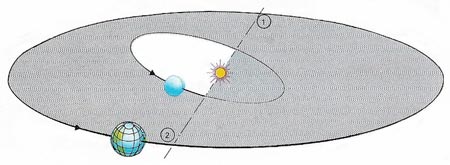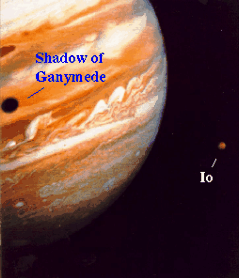transit

Figure 1. Transits of Mercury are rare as Mercury's orbital angle is different from Earth's. They usually occur in November (1) or less often, in May (2).

Figure 2. An example of a shadow transit by a Galilean moon. Jupiter, Io, and the shadow of Ganymede on Jupiter.
A transit is the passage of a smaller astronomical object across the face of a larger one, as in a transit of Venus or Mercury across the Sun, or the transit of a moon across its primary. In the latter case, if the transit involves the Moon’s shadow rather than the Moon itself, it is known as a shadow transit. Transits of Venus and Mercury can only take place when the planets are close to the nodes of their orbits at inferior conjunction: in early December or early June for Venus, and in early November or early May for Mercury.
A transit is also the passage of a meridian or surface marking across the central meridian of the disk of a rotating planet.
A transit is also the instant at which a star or other celestial object crosses the observer’s meridian; also known as culimination or meridian passage (see upper and lower transits.
Upper and lower transits
Upper transit, also known as upper culmination, is the meridian passage from east to west of an object above the pole, that is, between the north pole and the south point on the horizon, for an observer in the northern hemisphere. Lower transit, also known as lower culmination, is the point at which a celestial object reaches its minimum altitude on the observer's meridian.
Shadow transit
A shadow transit is the passage of the shadow of a moon, cast by the Sun, across the face a planet. The easiest to see are those of the Galilean satellites on Jupiter (Figure 2) and of Titan on Saturn. Occasionally, shadow transits of several of the other larger moons of Saturn can be seen through very large telescopes.


